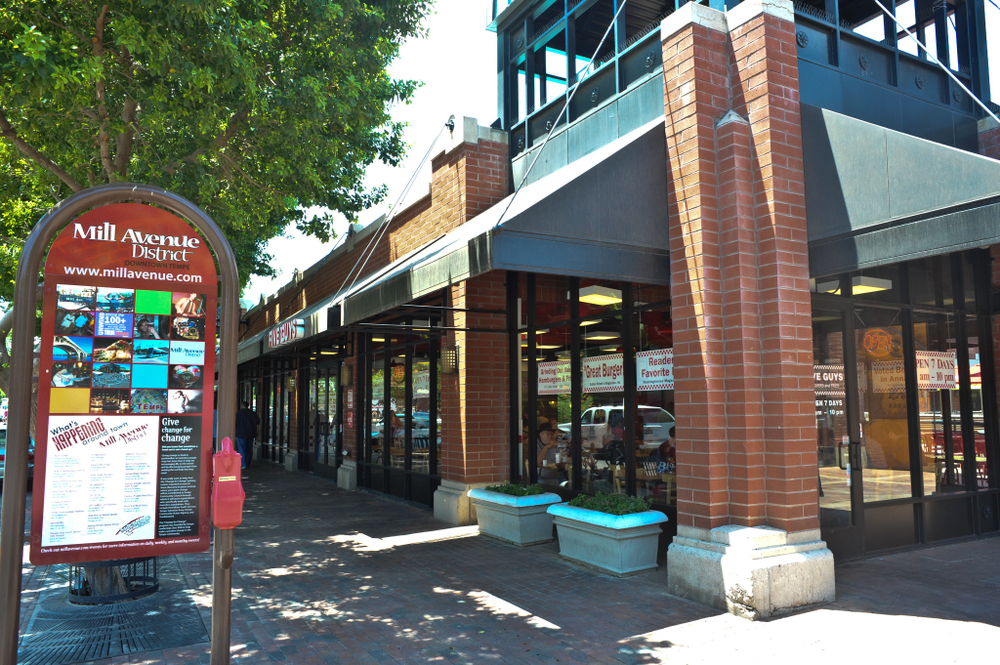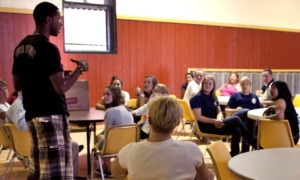
By PICTOR PICTURE COMPANY/Shutterstock
Downtown Tempe, Ariz.
It is an arid, 100-degree August night in Tempe, Ariz. Five of us are volunteering on outreach in the downtown area tonight on behalf of a nonprofit that serves homeless youth and young adults. We gather in a parking lot near the main strip and pack backpacks heavy with water bottles, food and hygiene supplies and then walk the main avenue to find youth who might need help. When we meet them, we make what service referrals we can based on our knowledge of the human service system, but mostly we try to treat the youth with dignity — and learn and share and grow with them — despite their housing status.
We’ve been chatting with a dozen homeless youth and young adults in an unused walkway connecting two parts of the downtown area. Two of us listen to a young woman who recounts her medical challenges of being pregnant living on the street, and the rest sit on the concrete, still warm from the day, while chatting with a group of young men. One of them is pouring his recently acquired water into a cup so his dog can drink. The pit bull mix lies stretched out, long and lanky, near two more people — one sitting on a duffle and the other reclined on the concrete with his head propped on his backpack.
As we talk, listen and laugh, I see two black-uniformed men on black bikes riding slowly past, 50 or so meters (about 160 feet) away. They circle us. They seem to me like circling coyotes.
The police officers on bike patrol ride over. Without dismounting, one of them addresses the group.
“You gotta leave. Pick up your damn trash and get out of here.”
One of the youth says something in reply; I can’t make it out.
“You’ve got trash everywhere, people have got their shoes off, stuff is everywhere …” The group begins to pack their things. We stick around and help grab some of the trash. The youth put on their shoes, shoulder their bags and move.
Displacement
But it’s almost humorous what counts as “getting out of here.” The center of the group moves 30 feet west, but with their sprawl, the eastmost person of the group is only two steps west of the westmost person in the old spot. An amoebic migration at best. When the last person has cleared the invisible western line of the old sprawl, the officers cycle into the night without a word.
The group of young people has been “moved along,” but they still have nowhere to go.
Laws, and the systems that uphold and enforce them, are designed to promote peace and security in society. Of course, no system, legal or otherwise, equally advantages all people. But in the case of youth who live without homes in the United States, they often find that the system of laws and law enforcement in place can condone, encourage or even commit violence against them.

Tim Huffman
The above story isn’t a story about overt victimization. Rather, it is a banal sort of interpersonal and environmental violence. The bland and meaningless reshuffle of the fragile ecosystem does nothing to help anyone. It just drives deeper disconnection.
Sadly, homeless youth are at risk for violence beyond perpetual displacement. Not only are they more likely to be the victims of crime than youth with fixed and adequate shelter, some find themselves being attacked by law enforcement officers while they sleep at night or have their possessions — including IDs and birth certificates — taken and discarded for seemingly no reason. I knew one young man who would wait until the cover of night to climb buildings and sleep on roofs to avoid violent policing.
The story above, as well as the examples of problems and solutions below, are drawn directly from a 2½-year qualitative research project on youth homelessness in Phoenix. For the last 10 years, I have worked as both a scholar and an activist around issues of homelessness in Los Angeles, Phoenix and St. Louis. During this time, I have both directly witnessed and listened to retellings of violence directed toward homeless youth.
To be clear, not every interaction between youth and the law is violent. I’ve seen compassionate and strategic law enforcement officers work very hard on behalf of people without homes, and cities and citizens work tirelessly to change practices and policies. But when roughly 15% of homeless youth report violence from police officers within the last six months, we must recognize that an entire legal, economic and cultural system creates the conditions that encourage violence. In the spirit of fully understanding the scope of the problem, consider three scenarios.
Scenario 1
A city creates a set of laws about how humans can use the urban center. In practice, these are anti-homeless laws. They effectively make having a body in the city without money illegal, as they punish sitting, sleeping, eating, sheltering, using the bathroom and interacting with passersby. Of course all people do these things, but they are used to control the movements of people without homes.
Youth, who often appreciate and contribute to the vibrant and artistic energy of downtown areas, are particularly affected by them. These laws and the way they are taken up by so-called hospitality and safety workers push homeless young adults away from the city center, usually into less public spaces. Being in less public places means they are less likely to be considered loitering, but it also means they are more vulnerable to crime as there are fewer witnesses.
Scenario 2
As relationships sour between homeless youth and law enforcement officers, the youth are less likely to seek legal recourse when they have been the target of violence or another crime. This is a composite of a belief that their reports will not be taken seriously and the anxiety that any interaction with law enforcement systems is likely to have consequences. Even if the young person is not currently breaking a trespassing or other anti-homeless law, a history of rude or violent interaction increases the likelihood that law enforcement is a trauma trigger for the youth. As such, crimes against homeless youth are more likely to go unreported and victimization (from theft to sexual violence) is more likely to continue.
Scenario 3
Quite reasonably, shelters and community mental health response systems collaborate with law enforcement officers in the course of their work. Sensible policies, such as sending law enforcement officers to a scene where harm to self or other has been threatened, are a norm. That said, these collaborations can have impacts on youth who try to use the services, particularly as a history of troubled interactions develops. Critical resources can be harder to access if they require the young person to pass through structures of law enforcement to get them.
Young people who barely manage to call a mental health organization instead of committing suicide might find themselves approached by large blue armed and armored men who are not particularly talented in mental health response and whose bodies bear a symbolic history of violence they do not control. Even when we try to be compassionate, we cannot always overcome the past traumas another person has.
In short, U.S. systems of law and law enforcement can themselves be agents of violence toward young people who are unhomed.
But all is not lost. There are examples of communities that take seriously the need for the legal system to work for all. This sort of work is challenging and requires significant engagement from various stakeholders. But there are examples of promising practices.
For instance, there are various movements around the United States that have taken up the issues of unjust urban anti-homeless laws and have advocated against them. Various cities have strong homeless bill of rights movements. Relatedly, recent rulings in federal courts have revoked the power to prosecute someone for sleeping outside when there is no adequate shelter available. Further, food distribution has been recognized as an expression of free speech. While there is much more work to do, these activist and judicial examples offer a picture of how legal systems can change.
Further, law enforcement officers can be part of a humane response to issues of poverty. There are examples of community shelters that have created enough trust with their policing community that officers disarm themselves before entering the shelter. This symbolic and material act changes how they encounter and are encountered in these spaces.
Further, some communities make significant efforts to improve the training and resources that law enforcement officers receive with regard to people experiencing homelessness. By augmenting the communicative and interorganizational tools that officers can deploy, the social and legal possibilities of interaction broadens significantly.
In moving beyond the above examples, I offer a simple thought experiment that various professionals can use to create their own solutions for working in more humane and life-giving ways with homeless youth. It takes the simple form of a question and a follow-up question:
Does this law, policy or practice assume that the person has a home?
If so, what steps could I take or accommodations could be made to avoid the negative outcomes that may come from a standard application of said practice?
In closing, it is valuable to remember that homelessness is often a violent experience in that it is unwanted and painful. It isn’t that the legal structure is uniquely violent. Economic, familial, cultural and elemental realities are also poised to harm. But legal systems, like many of those realities, are real because we made them, and if we make them differently, they can more fully contribute to the creation of a society that is more fair and free.
Tim Huffman is an associate professor of communication studies at Saint Louis University. His activism and research focuses on homelessness in various contexts, including street outreach, supportive housing, creative program design and regional strategic planning.































